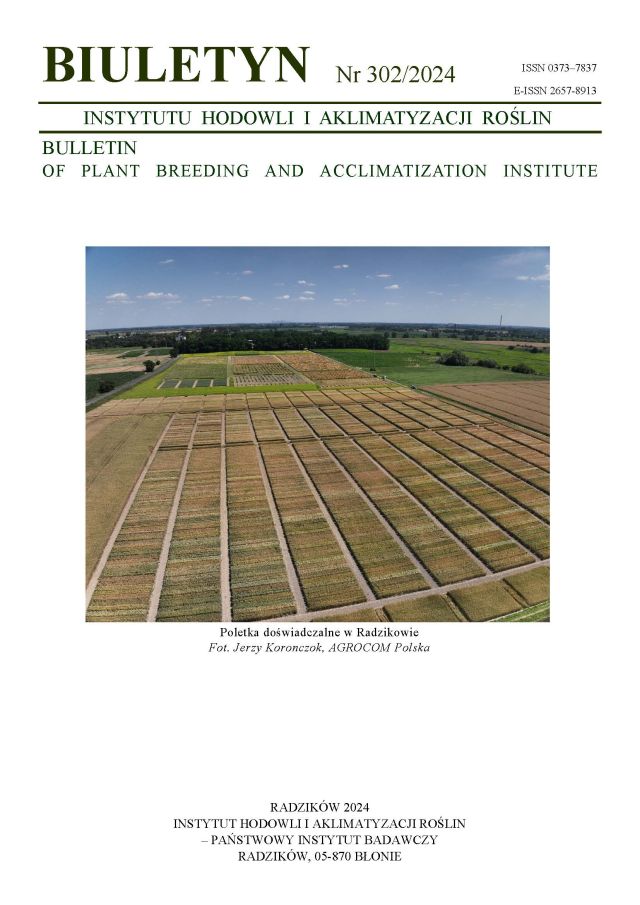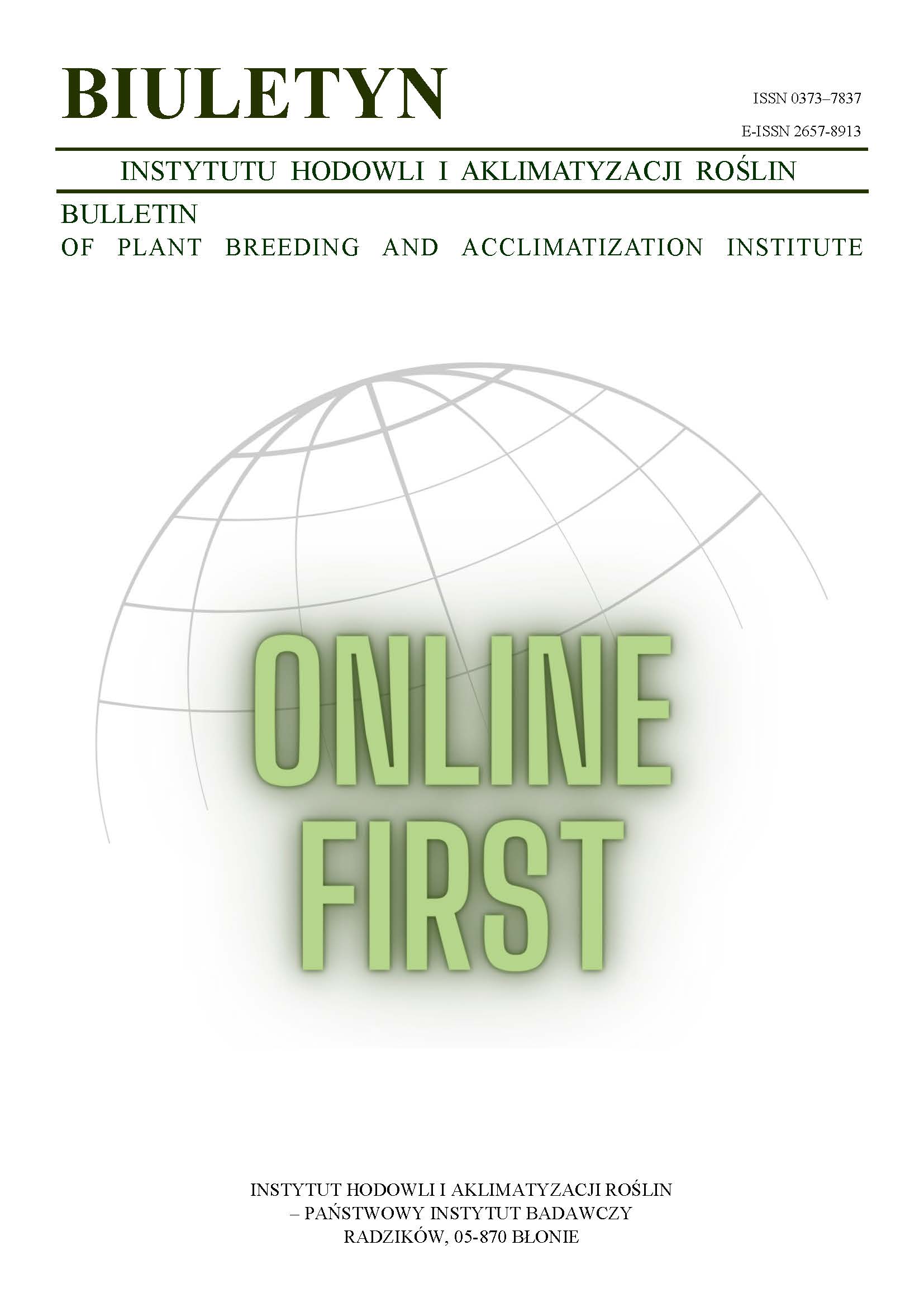Effect of nitrogen rate on yielding of spring barley cultivars in a pot experiment
Kazimierz Noworolnik
iung@iung.pulawy.plZakład Uprawy Roślin Zbożowych, Instytut Uprawy, Nawożenia i Gleboznawstwa w Puławach (Poland)
Danuta Leszczyńska
Zakład Uprawy Roślin Zbożowych, Instytut Uprawy, Nawożenia i Gleboznawstwa w Puławach (Poland)
Abstract
Two series of pot experiment were carried out in the period of 2000–2002 to determine the response of 8 spring barley cultivars to three nitrogen fertilization rates: 1, 2 and 3 g N per pot. The Justina and Annabell cultivars showed significant increase of grain yield with increase of N rate to 3 g per pot. For the remaining cultivars, significant differences of yield increase were observed between the doses of 1 g N and 2 g N per pot; the yields at 2g N and 3 g N per pot were similar. The grain yield increment was related to increase of productive tillering rate. All cultivars showed great increase of protein content in grain with increase of N rate.
Keywords:
cultivars, grain yield, nitrogen dose, spring barley, yield componentsReferences
Brvkovič M., Lazovič D. 1986. Utičaj povecanih kolcina dubriva na prinos i morfolske osobine nekih sorata jarog ječma. Agrohemija. 5/6: 389 — 396.
Google Scholar
Cyfert R., Michalak A., Najewski A., Zych J. 2004. Wyniki porejestrowych doświadczeń odmianowych. Zboża jare. 22.
Google Scholar
Kamińska J., Mazgalska W. 1988. Reakcja odmian i rodów jęczmienia jarego na nawożenie azotowe w doświadczeniu wazonowym. Biul. IHAR 165: 15 — 33.
Google Scholar
Kulik D. 1981. Ertragsstruktur bei Sommergerste unter dem Einfluss unterschiedlicher Düngungsintensität. Braugerstetagung, Halle: 219 — 234.
Google Scholar
Leszczyńska D., Noworolnik K. 1998. Reakcja odmian jęczmienia jarego na nawożenie azotem w warunkach kontrolowanych. Pam. Puł. 112: 145 — 149.
Google Scholar
Noworolnik K. 1990. Plonowanie odmian jęczmienia jarego na różnych dawkach azotu. Biul. IHAR 176: 37 — 41.
Google Scholar
Noworolnik K. 1996. Reakcja odmian i rodów jęczmienia jarego na poziom nawożenia azotem. Biul. IHAR 197: 121 — 125.
Google Scholar
Noworolnik K. 2003. Wpływ wybranych czynników agrotechnicznych na plonowanie jęczmienia jarego w różnych warunkach siedliska. Monogr. i Rozpr. Nauk., IUNG, 8: 1 — 66.
Google Scholar
Noworolnik K., Leszczyńska D. 2000. Reakcja odmian jęczmienia jarego na poziom nawożenia azotem. Biul. IHAR 214: 163 — 166.
Google Scholar
Noworolnik K., Leszczyńska D. 2002. Porównanie reakcji odmian jęczmienia jarego na poziom nawożenia azotem. Biul. IHAR 221: 67 — 72.
Google Scholar
Petkowa M. 1989. Vlijanie na mineralnoto toreno vrchu produktivnosta na novi sortove pivovaren ecemik. Rasten. Nauki, 26 (4): 24 — 27.
Google Scholar
Prugar J., Strnad P. 1981. Einfluss der N-Düngung auf Ertrag und Qualität der Sommergerste. Braugerstetagung, Halle: 211 — 218.
Google Scholar
Ruszkowski M. 1984. Możliwość oceny reakcji odmian jęczmienia jarego na nawożenie azotem w doświadczeniach wazonowych. Biul. IHAR 154: 15 — 18.
Google Scholar
Authors
Kazimierz Noworolnikiung@iung.pulawy.pl
Zakład Uprawy Roślin Zbożowych, Instytut Uprawy, Nawożenia i Gleboznawstwa w Puławach Poland
Authors
Danuta LeszczyńskaZakład Uprawy Roślin Zbożowych, Instytut Uprawy, Nawożenia i Gleboznawstwa w Puławach Poland
Statistics
Abstract views: 57PDF downloads: 25
License
Copyright (c) 2005 Kazimierz Noworolnik, Danuta Leszczyńska

This work is licensed under a Creative Commons Attribution-ShareAlike 4.0 International License.
Upon submitting the article, the Authors grant the Publisher a non-exclusive and free license to use the article for an indefinite period of time throughout the world in the following fields of use:
- Production and reproduction of copies of the article using a specific technique, including printing and digital technology.
- Placing on the market, lending or renting the original or copies of the article.
- Public performance, exhibition, display, reproduction, broadcasting and re-broadcasting, as well as making the article publicly available in such a way that everyone can access it at a place and time of their choice.
- Including the article in a collective work.
- Uploading an article in electronic form to electronic platforms or otherwise introducing an article in electronic form to the Internet or other network.
- Dissemination of the article in electronic form on the Internet or other network, in collective work as well as independently.
- Making the article available in an electronic version in such a way that everyone can access it at a place and time of their choice, in particular via the Internet.
Authors by sending a request for publication:
- They consent to the publication of the article in the journal,
- They agree to give the publication a DOI (Digital Object Identifier),
- They undertake to comply with the publishing house's code of ethics in accordance with the guidelines of the Committee on Publication Ethics (COPE), (http://ihar.edu.pl/biblioteka_i_wydawnictwa.php),
- They consent to the articles being made available in electronic form under the CC BY-SA 4.0 license, in open access,
- They agree to send article metadata to commercial and non-commercial journal indexing databases.
Most read articles by the same author(s)
- Alicja Sułek, Danuta Leszczyńska, Actual state and perspectives of oats cultivation in Poland , Bulletin of Plant Breeding and Acclimatization Institute: No. 231 (2004): Regular issue
- Danuta Leszczyńska, Kazimierz Noworolnik, Comparison of response of six-row and two-row winter barley cultivars to nitrogen fertilization level and sowing date , Bulletin of Plant Breeding and Acclimatization Institute: No. 237/238 (2005): Regular issue
- Kazimierz Noworolnik, Danuta Leszczyńska, The response of naked spring barley to sowing rate in comparison to husked barley , Bulletin of Plant Breeding and Acclimatization Institute: No. 233 (2004): Regular issue
- Kazimierz Noworolnik, Danuta Leszczyńska, Effect of sowing rate and sowing date on grain yield and its structure in spring barley cultivars , Bulletin of Plant Breeding and Acclimatization Institute: No. 231 (2004): Regular issue














